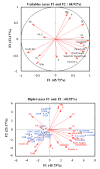Exploring the Correlation Between Salt Tolerance and Seed Nutritional Value of Different Quinoa Genotypes Grown Under Saharan Climatic Conditions
- PMID: 39599400
- PMCID: PMC11597728
- DOI: 10.3390/plants13223180
Exploring the Correlation Between Salt Tolerance and Seed Nutritional Value of Different Quinoa Genotypes Grown Under Saharan Climatic Conditions
Abstract
Quinoa is an annual pseudocereal highly adapted to extreme environments and has become, at this point in time, an extremely popular food due to its exceptional and high nutritional quality. This study aims to investigate the association of quinoa salt tolerance at an early developmental stage with its grain nutritional value under the effect of severe climatic hurdles. The current findings revealed a significant variability between genotypes in salt response attributes at the first development stage, where genotypes Amarilla Sacaca (thereafter, A. Sacaca) and QQ57 exhibited high salt tolerance thresholds with a low salt sensitivity index (SI), and a high capacity for Na+ sequestration into vacuoles. A significant positive association was detected between salt tolerance degree and yield parameters, saponins (SAPs), and minerals contents, where genotype A. Sacaca exhibited the highest SAP content with 3.84 mg.g-1 and the highest amounts of K, Ca, P, and Fe. The analysis of fatty acid composition demonstrated a high significant negative correlation between crude fat content and salt SI, and between yield parameters. Despite its low harvest index (HI) and low seed oil content, the salt-tolerant genotype A. Sacaca showed a high nutritional quality for seed oil according to its lowest ω6/ω3 ratio (5.6/1) and lowest level of atherogenicity index (AI). The genotype 115R, defined as the most sensitive to salt stress, exhibited a high seed oil quality due to its low lipid peroxidation susceptibility as reflected by its oxidative susceptibility and peroxidizability indexes. The significance of this study includes the identification of valuable quinoa genotypes showing high efficiency in growth and yield under severe stress accompanied by a high nutritional value satisfying the market requirements for healthy, nutritious, and safe food products.
Keywords: SAPs; fatty acids; nutritional value; salt tolerance; variability.
Conflict of interest statement
The authors declare no conflicts of interest.
Figures







References
-
- González J.A., Eisa S.S.S., Hussin S.A.E.S., Prado F.E. Quinoa: An Incan Crop to Face Global Changes in Agriculture Quinoa. In: Murphy K., Matanguihan J., editors. Quinoa: Improvement and Sustainable Production. John Wiley & Sons, Inc.; Hoboken, NJ, USA: 2015. pp. 1–18. - DOI
-
- Garcia M., Condori B., Del Castillo C. Agroecological and agronomic cultural practices of quinoa in South America. In: Murphy K., Matanguihan J., editors. Quinoa: Improvement and Sustainable Production. John Wiley & Sons, Inc.; Hoboken, NJ, USA: 2015. pp. 25–46. - DOI
-
- Valencia-Chamorro S.A. QUINOA. In: Caballero B., editor. Encyclopedia of Food Sciences and Nutrition. 2nd ed. Academic Press; Oxford, UK: 2003. pp. 4895–4902. - DOI
-
- Vidueiros S.M., Curti R.N., Dyner L.M., Binaghi M.J., Peterson G., Bertero H.D., Pallaro A.N. Diversity and interrelationships in nutritional traits in cultivated quinoa (Chenopodium quinoa Willd.) from Northwest Argentina. J. Cereal Sci. 2015;62:87–93. doi: 10.1016/j.jcs.2015.01.001. - DOI
LinkOut - more resources
Full Text Sources
Miscellaneous

